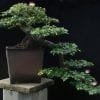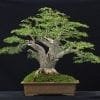Zelkova bonsai plants are known for being resistant to many of the diseases that commonly harm other species. They are typically associated with the broom style. This portrays a deciduous tree that has not been influenced by environmental factors. Zelkova plants are native to China and Japan, and they are related to elm trees. There are two species of Zelkova trees, and both are used to produce bonsai plants.
| Scientific/Botanical Name | Zelkova serrata |
| Description | This is a deciduous tree with a distinctly upright habit. The branches create a wide and beautifully-shaped arc. This tree is heavily favored for use in the art of bonsai, and it is particularly suited to the broom style. |
| Position | This tree is grown outdoors in a sunny aspect: A situation that receives full morning sun and filtered afternoon sunlight is optimal. If exposed to hot afternoon sun, leaf-burn will occur. If intense sun cannot be avoided, the use of some form of screening device is advisable. This tree must be given protection in areas where frost poses a threat. |
| Watering | The depth of the container and the climate will determine the watering schedule. To keep the soil moist, twice-daily watering may be required for shallower pots in hot, sunny locations. Less water is required in colder months, but soil should not be allowed to dry out. |
| Feeding | Regular feeding with an organic fertilizer is beneficial to the tree – and this should be carried out from spring to fall. A feeding schedule can either entail the application of half-strength fertilizer on a weekly basis, or the application of full-strength fertilizer every two weeks. |
| Leaf and Branch Pruning | Branches and twigs that spoil the look and symmetrical shape of the tree should be eliminated. Care should be taken during the removal of the sprouts that form on the branches and the trunk of the tree. |
| Re-potting & Growing Medium | Young trees should be re-potted every spring for greatest success. More mature trees need to be re-potted every second or third year, usually when the roots become pot-bound. A rich but easily-drained soil is best, and the addition of Fuji grit is an excellent amendment that aids drainage. When planting or re-potting, it is imperative that dry soil is used, and pressure should not be applied to the soil. Instead, the soil should be settled by a gentle back and forth shaking of the container. Once the tree is planted or re-potted, it should be watered immediately. |
| Wiring | Wiring is best carried out during the summer months. Great care should be exercised to prevent damage to the thin branches that can be easily broken. |
| Notes | Zelkova bonsai is highly resistant to diseases. Roots of immature plants are apt to appear above soil level. These need to be covered with a thin layer of soil to ensure thicker roots. More mature roots may be left above the soil for an appealing and visual impact. The green leaves of the tree impart a sweet-smelling fragrance during cold weather, but the fragrance is no longer discernible once the leaves have changed color. |
Where To Get A Zelkova Bonsai Plant
Many bonsai suppliers found online do not carry Zelkova plants. They are considered to be difficult to cultivate, and they do not grow quickly enough to be mass produced. Bonsai enthusiasts who want to grow a Zelkova plant will likely need to seek out a reputable bonsai nursery. They may also be available from larger landscaping stores.
How To Grow A Zelkova Bonsai Plant
Zelkova bonsai plants need ample sunlight in order to grow properly. They should be kept in places where they can get enough sunlight during the day. It is best to keep these plants in partial sunlight during the summer so that their leaves will not become dry. Some gardeners use special screens to protect the plants from the effects of the hot sun during the summer.
Zelkova bonsai plants grow best in soil that is well drained and fertile. They do well in loamy soil used in cultivated land and sandy loam found in the mountains. This soil should be sieved and dried thoroughly before it can be used. Zelkova plants should be planted in a pot with dry soil.
Gardeners should shake the pot after planting in order to help the soil settle around the plant. They should never apply pressure to the soil during planting. These plants should be watered immediately after they are placed in the pot.
Natural fertilizers should be used during the growth season. Gardeners can choose to give their plants a half dose of fertilizer weekly from spring until fall. They can also apply a full dose every other week.
Zelkova Bonsai Tips
Sprouts may appear in undesirable places on the trunk and branches at budding time in the spring. Gardeners should make sure that they are gentle when they cut or rub these sprouts off. Disproportionate or awkward twigs and sprouts should be removed in order to maintain symmetry in the plant.
Bonsai enthusiasts often find that their Zelkova plant’s roots come up through the surface of the soil. This tends to happen when the plants are young. Exposed roots should be lightly covered with soil when this happens.
Otherwise, the roots will not thicken. They need to be inside the soil in order to develop correctly. Roots that surface after the plant has matured can be left for an ornamental effect.
Wiring
Gardeners who want to wire their Zelkova bonsai plants should do so with great care. The plant’s branches are very thing and fragile. It is always best to only wire during the summer. However, gardeners can effectively use wires to mimic the natural growth of Zelkova trees in the wild.
Watering And Pots
Plants that are kept in shallow pans will likely need to be watered often during the summer. Zelkova plants can dry out rapidly during this time. These plants may need to be watered twice every day during the summer. Watering once a day is usually sufficient during the spring and fall.
Zelkova plants can be watered every other day during the winter. These plants grow best when they are kept in deeper pots. Younger plants should be repotted yearly in the spring. Older Zelkova bonsai plants can be repotted every few years.
Broom Style
Most people who grow this species want to achieve a broom style. To do this, they should ensure that the trunk is straight and allow the plant to grow until the trunk reaches the desired thickness.
They should then remove the tap root and cut the trunk above where the branches will diverge. The branches below that point should be allowed to grow out and then pruned back to just a few internodes.
They should then be allowed to grow out again. The branches should be gathered into a broom shape with a raffia before the buds open in the spring.
The new growth from the branches will start to fill in the broom shape. This process should be repeated until the right branch structure is achieved.
Zelkova bonsai plants are relatively easy to care for, but they can be difficult to maintain and style. Beginners can grow these trees, but they should not expect the quick and easy results that they may get with other species.
They also do not bud back easily like some other plants do. Growing a properly styled Zelkova bonsai plant can take many years, but achieving a perfect broom shape is worth all of the effort and perseverance.


